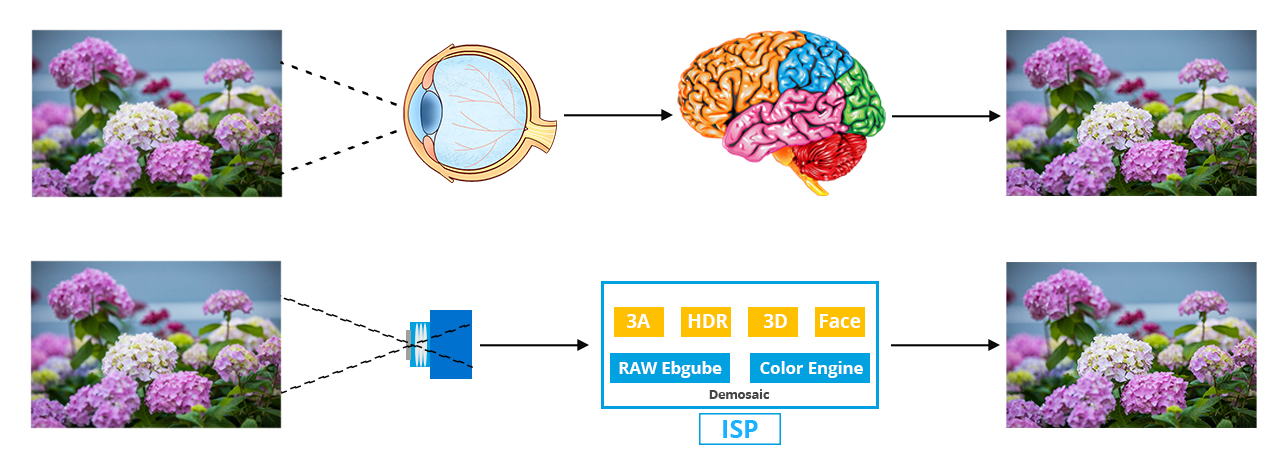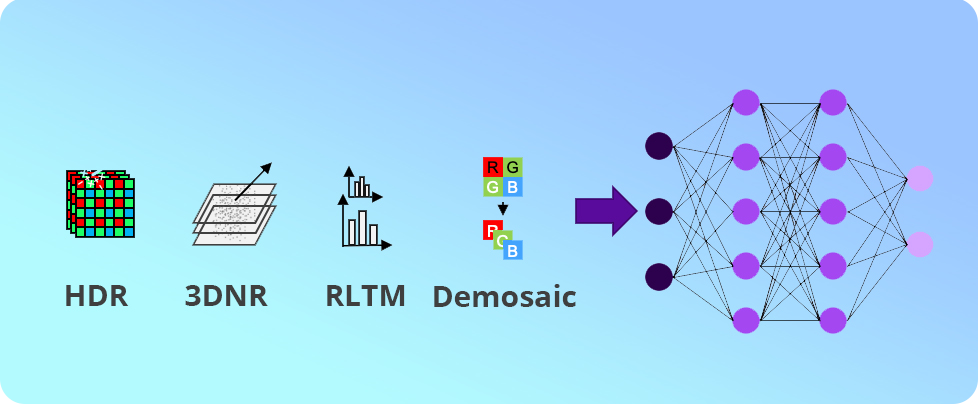From the early days of smartphones with a few million pixels to today's DSLR cameras and smartphones with tens of millions or even over a hundred million pixels, the relentless pursuit of perfect image quality has driven the iterative advancements in imaging devices. After all, in the face of our own eyes, with their astonishing 576 million pixels of resolution, everything still seems less real.
, "Rozwój kamer zawsze opierał się na wsparciu technologii ISP (Image Signal Processor). W przypadku tradycyjnej technologii ISP rejestrowanie scen nocnych i scen o wysokim zakresie dynamiki (HDR) było szczególnym wyzwaniem. Problemy takie jak szum, rozmycie ruchu, prześwietlenie i utrata informacji przy słabym oświetleniu w dynamicznych scenach nocnych nie tylko nie zaspokajają rosnącego zapotrzebowania na rejestrację obrazu, ale także hamują postęp branż takich jak nadzór wideo i zarządzanie ruchem
Yet, technology continues to break barriers, always surpassing our imaginations. While people are still critical of the flaws in traditional ISP, the rapid progress of AI offers us more possibilities. The emergence of AI-ISP technology makes high-definition full-color imaging in extremely low-light conditions possible. Cameras are transitioning from "seeing" to "seeing clearly" and even "understanding" the scenes they capture.
The era of "True Black-light" is officially upon us.
"True Blacklight," empowering the intelligent IoT
Let's talk about "True Blacklight." Based on different night vision effects, cameras can be distinguished by various names such as low-light, starlight, super starlight, and blacklight. These terms don't have a unified standard, but the focus is on whether the camera can maintain full-color imaging under low-light conditions. Generally, "blacklight level" means that the camera can operate at 0.01lux or below.
Traditionally, achieving blacklight effects involved using large-format sensors, low-resolution sensors with larger pixel sizes, increasing aperture size, or reducing video frame rates to capture more light and color information at night. However, these methods often resulted in less than 100% color saturation, motion artifacts, and increased costs due to larger sensors and apertures, which couldn't fully meet industry demands.
In other words, "you can't have your cake and eat it too" in extremely dark environments.
Nevertheless, there is a solution with AI-ISP technology that brings true blacklight full-color imaging to reality. Cameras equipped with AI-ISP can achieve real-time color restoration at less than 0.01Lux without the need for white light or infrared illumination. The color saturation remains at or above 100%, and moving objects appear without significant trailing, ghosting, or perspective issues. According to experts, only by meeting the following six key elements can it be called "True Blacklight" and truly help users achieve better video performance in extremely dark scenarios.

Thanks to the breakthrough of "True Blacklight," smart cities and intelligent IoT have expanded their application scenarios. In extremely dark environments like intersections, mountains, ponds, and farmlands, video brightness can be enhanced without sacrificing image quality, enabling cameras to capture well-structured, accurately color-restored color videos. Additionally, this technology achieves full-scene video effects, providing more precise intelligent analysis in places like ponds and farmlands where supplementary lighting is not feasible.
, "Kluczowe moduły wspomagane sztuczną inteligencją, zoptymalizowane pod kątem krawędzi - maksymalizujące wydajność AI-IS
, "ISP to skrót od Image Signal Processor, odpowiedzialny za konwersję sygnałów z czujników obrazu na rozpoznawalne informacje dla ludzi i maszyn. Odgrywa kluczową rolę w jakości obrazu. Posługując się ludzką analogią, ISP działa jak mózg systemu obrazowania, przetwarzając, ulepszając i ulepszając obrazy zebrane z czujnika obiektywu, aby zapewnić prawdziwą lub nawet lepszą jakość obrazowania

Traditional ISP takes the raw data output from CIS sensors and converts it into human-readable YUV data following a specific pipeline sequence. Image processing in traditional ISP relies on mathematical modeling and human's naive understanding of images. In contrast, AI-ISP, a recent technological concept, builds upon the traditional ISP pipeline but overcomes its limitations using AI neural networks. By simulating the human brain with richer parameters and establishing more complex models, AI-ISP surpasses the ceiling of traditional ISP, achieving superior image quality.
, "Obecnie AI-ISP wzmacnia cztery krytyczne moduły w potoku ISP — HDR, 3DNR, RLTM i Demosaic — poprzez ciągłe zwiększanie ich wydajności poprzez szkolenie AI. Ten przełom w AI-ISP przełamuje ograniczenia tradycyjnego obrazowania ISP

Powodem, dla którego zdecydowaliśmy się na wykorzystanie kluczowych modułów do sztucznej inteligencji, jest to, że moc obliczeniowa po stronie brzegowej jest często ograniczona. Biorąc pod uwagę praktyczne wdrożenie z obawami dotyczącymi zużycia energii i kosztów, zastosowanie przetwarzania AI do całego potoku nie jest wykonalne. AI-ISP, w istocie, jest bliższy prawdziwej produktizacji, ponieważ koncentruje sztuczną inteligencję na najbardziej krytycznych i wizualnie dostrzegalnych funkcjach, jak najlepiej wykorzystując ograniczoną moc obliczeniową w celu uzyskania optymalnej wydajności AI-ISP
, "Dlatego w praktycznych zastosowaniach AI-ISP może zwiększyć wydajność poprzez iterację modeli wizualnych, ułatwiając szybką aktualizację produktu chipowego pod względem jakości obrazu. Oznacza to, że pojedynczy układ scalony może obsługiwać różne scenariusze i rynki, zmniejszając ogólne koszty aplikacji AI i znacznie zwiększając produktywność
Regarding the relationship between AI-ISP and "True Black Light," experts point out that in the era of 0.01 lux black light, simply improving lenses and sensors cannot address the fundamental issues. Traditional ISPs are unable to meet the technological advancement demands for black light, leading to various misleading approaches such as frame rate reduction and increased supplementary lighting. They believe that a qualified true black light full-color camera should ensure real-time (25-30) fps performance without the need for supplementary lighting in 0.01 lux scenarios, accurately distinguish moving objects, and faithfully reproduce colors. This is precisely the distinctive advantage of AI-ISP.
In fact, it was in 2020 that AI-ISP officially entered the market, leading to the rapid development of the new category of "True Black Light Full-Color Cameras."
As we can see, with the increasing demand for higher imaging quality in extreme scenarios such as low-light, high dynamics, and light pollution, AI-ISP is becoming increasingly crucial in the field of artificial intelligence visual imaging. By innovatively addressing the industry's core pain points related to low light and high dynamics, AI-ISP has created new product categories like the True Black Light Full-Color Camera, unlocking new visual possibilities for people. In the future, it may even lead us into a new era of imaging.